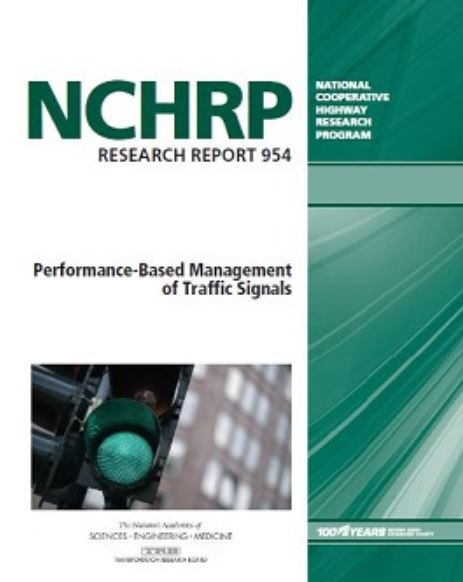March 17, 2021
NCHRP Report 954 Gives Agencies the Keys to Performance-Based Signal System Management
Traffic signals can do more than direct traffic. Beyond flashing green, yellow, and red, they contain a wealth of information that, to this day, is largely untapped.
When data from traffic controllers is harnessed, they become one of our industry’s greatest assets in signal timing and systems management.
Dr. Darcy Bullock of Purdue University and Dr. Christopher (Chris) Day of Iowa State University, both national leaders in ITS, recognized this more than 20 years ago, and ever since they’ve been at work to make automated traffic signal performance measures (ATSPMs) a reality for transportation agencies. ATSPMs use infrastructure and technology that often already exists at signalized intersections to pull comprehensive information about how those intersections and corridors are functioning.
Using ATSPMs is a proactive approach to signal system management because data is collected in real time, giving agencies the ability to measure, not predict, how intersections are performing-to “work smarter, not harder.” This helps an agency respond to what the data is saying as they prioritize maintenance activities, prioritize retiming activities, and identify capital improvements. (For more about the building blocks of ATSPMs, read our primer here.)
“It’s the power of having the information to prove exactly what’s going on,” says Chris. “The alternative is the occasional traffic counts plugged into a model to try to predict what will happen, or a video feed you have to sit in front of and watch.”
More and more agencies are becoming familiar with ATSPMs and their benefits. The challenge lies in implementation. It’s difficult to find the skillset and time in-house to operationalize ATSPMs. And public agencies are typically not set up to take in and work with that much data.
NCHRP Report 954-released in February 2021 and authored by Chris, Darcy, Alison Tanaka of Portland Bureau of Transportation (PBOT), along with a team led by Kittelson-provides a path forward.
NCHRP Report 954: What’s In the Guidebook

NCHRP Report 954 has two main purposes, says Alison Tanaka, senior engineering associate at PBOT and one of the lead authors of the guidebook. The first is to provide information to decision makers at public agencies who are evaluating if they should use ATSPMs. The first chapter of the guidebook outlines the benefits of collecting real-time, continuous information at signalized intersections to get ahead of issues, retime signals efficiently, and ultimately manage the network in a data-driven way as ATSPMs are deployed at a large scale.
For agencies who know they want ATSPMs, the guidebook’s second purpose is to help them understand the suite of performance measures that area available to them, what pieces they need in order to actually get the data, and how to use the data to make changes to their system. Chapter 2 guides the reader through selecting the performance measures that match their goals, objectives, and methods of signal system management. Chapter 3 then provides a list of 26 signal performance measures with details on each.
“We didn’t set it up expecting that someone would go through and read that entire chapter from front to end,” said Alison. “We wanted to provide a lot of references so that as someone goes through and reads about the objectives they want to accomplish, they can select the performance measures that are related and jump to that section. It all goes back to what you want to achieve with the performance measures.”
Once an agency has identified the signal performance measures they want to implement, they can use Chapter 4 to understand what resources are required, including data sources and detection, and start a procurement process for those resources. Chapter 5 explains how to deploy the system and check that intersections have been configured correctly, and Chapter 6 provides strategies to fully integrate signal performance measures into agency management practices.
“To me, this report is a good one for the decision makers,” said Darcy. “It provides a summary of the history and foundational work, but then translates data into information that decision makers can act on.”

When data from traffic controllers is harnessed, they become one of our industry's greatest assets in signal timing and systems management.
The Foundations of NCHRP Report 954
Though just published in early 2021, the work that has gone into this guidebook started many years ago.
Darcy, who is a Professor of Civil Engineering and Director of the Joint Transportation Research Program at Purdue University, has been working for more than two decades to piece together foundational elements of ATSPMs, partnering with Indiana DOT, his university, and local agencies in what he calls his “living lab” to test out theories and understand what building blocks are needed for scalable ATSPMs.
“It was probably about 10 years of very nuts and bolts, down to the wiring level, to get to the point where we could get sustained data so we could turn that data into actionable information,” Darcy remembers.
Darcy and Chris were leaders of the Transportation Pooled Fund Program’s Traffic Signal Systems and Operations and Management TPF-5(258), which between 2012 and 2017, developed best practices for implementing ATSPM systems and using the data collected. Prior to this study, there was limited consensus on standards of performance or best practices for cost-effectively managing system operations.
Kevin Lee is a principal engineer at Kittelson who studied under Darcy at Purdue University and participated in much of the early work behind signal performance measures. He explains that this pooled fund study was important for standardizing the components and the inputs and outputs of ATSPMs for consistency across the industry.
“That study was the start of the snowball of figuring out: How does it work? How do you name things? What system do you need?” said Kevin. “One piece was still missing: helping agencies implement it.”
Kevin championed the effort to get NCHRP Report 954 created to fill that gap. The guidebook pulls together work that has been done from the pooled fund study until today to chart a course for agencies in implementing ATSPMs. It has also been largely shaped by agency participation.
“We were very fortunate to have really strong participation from DOTs at different steps along the way,” said Chris. “We couldn’t have done this without Indiana DOT early on-their field infrastructure and their willingness to work with us. Later on, Utah DOT came along and injected a lot of energy into the whole thing. They helped carry it to the national level. They developed an open source software to actually produce the performance measures that we had prototyped earlier. We’ve also seen participation from other agencies since then, including Georgia DOT and Pennsylvania DOT.”
This participation from agencies has enabled the guidebook to address practical challenges that agencies everywhere face with the change management of switching to ATSPMs.
Applying NCHRP Report 954
As someone who understands the challenges with implementing ATSPMs, Alison explains that the guidebook will be helpful to her and her team at PBOT.
“We’ve gotten past the point of deciding we want to use performance measures. Most of the engineers and managers are on board and see the benefits of having this data available. I think the next step for us is utilizing some of the chapters on the best way to set up data collection,” she said. “One of the biggest challenges for a lot of agencies is getting this on the ground. It’s a lot of data to collect. You have to figure out a place to put it and learn how to maintain it over time. The guidebook provides information on those pieces.
“For the majority of our staff, the guidebook will serve as a resource for the specific performance measures and provide information about how to read the charts and apply them. Being able to point to this guidance document as a resource will be very helpful.”
Alison also notes that PBOT is seeing benefit from ATSPMs as they go, even before large-scale deployment.
“It’s the benefits you can see if you’re measuring what’s going on, versus predicting what could be happening through a model,” she said. “We haven’t even gotten to the level of being able to aggregate these performance measures up to get broader operational information-we’re just using them for pinpointing trouble spots, and even that the engineers have found extremely useful.”
A Step Toward Widespread Implementation of ATSPMs
“The industry is on an exciting trajectory,” said Kittelson CEO Brandon Nevers, who was also on the team that authored the guidebook. “Until recently, the agencies implementing ATSPMs were the early adopters. Now, we’re seeing a widespread interest. A lot has happened to get us here, and NCHRP 954 is a key step in giving agencies the tools they need.”
Agencies that put in the work today to set up ATSPMs will continue to reap the benefits in the future, noted Alison.
“One of the benefits of signal performance measures is the base leaves so much room for new performance measures,” she said. “In Portland, we’ve been talking about performance measures that could be developed for multimodal applications, like transit signal priority and as detection becomes better for bicycles and pedestrians. The other thing I see is different groups pushing the envelope with AI and machine learning. A lot of the systems now require you to look at trends over a day, week, or month, but in the future we could project what’s going to happen based on years of historical data.”
We at Kittelson are passionate about helping our clients leverage technology and available data to make informed decisions. Our work in signalized performance measures dates back to the mid-1990s, including authorship of both editions of the Signal Timing Manual. Today, we’re excited to be working with several agencies to help them set up and scale up their ATSPM systems. We are also grateful for the work of Darcy, Chris, Alison, and many others who have advanced these important concepts.
Kevin summarizes it this way: “What gets measured gets approved. This guidebook provides the pathway to measure and manage your signal system.”
NCHRP Report 954 can be found and downloaded for free on TRB’s website. To talk more about application of this guidance, contact Kevin Lee at klee@kittelson.com or Brandon Nevers at bnevers@kittelson.com.
—
NCHRP Report 954 Panel and Author Acknowledgements
Thank you to the following panel members for their contributions to this project:
Mark Taylor, Utah Department of Transportation, Salt Lake City, UT (Chair)
Dan Farley, Pennsylvania Department of Transportation, Harrisburg, PA
Julie Kentosh, Portland Bureau of Transportation, Portland, OR
Telma Lightfoot, Kentucky Transportation Cabinet, Frankfort, KY
Gil Ramirez, Lassiter Transportation Group, Inc., Melbourne, FL
Troy Rother, City of College Station, College Station, TX
Philip Rust, City of San Diego, San Diego, CA
John Shaw, University of Wisconsin-Madison, Madison, WI
Jim Sturdevant, Indiana Department of Transportation, Indianapolis, IN
Eddie Curtis, FHWA Liaison
Doug Noble, Institute of Transportation Engineers Liaison
Richard Cunard, TRB Liaison
In addition to the panel, the following public agency staff contributed insights regarding the cross section of public agency needs related to the management of traffic signal systems: Joanna Bush, Wisconsin Department of Transportation; Alan Davis, Georgia Department of Transportation; Rob Klug, Clark County, Washington; Jim Larsen, Ada County Highway District, Idaho; Ling Li, Virginia Department of Transportation; Steve Misgen, Minnesota Department of Transportation; Shital Patel, Regional Transportation Commission of Southern Nevada; Raj Ponnaluri, Florida Department of Transportation; Martha Styer, Caltrans; Nhan Vu, Virginia Department of Transportation; and Charlie Wetzel, Seminole County, Florida.
